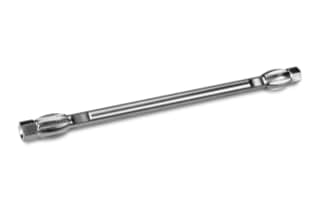
XTerra MS C18 columns are general purpose, hybrid-based, reversed-phase C18 columns that are designed to be compatible with mass spectrometry applications. These first generation columns provide superior pH stability compared to a silica-based column.
|
Chemistry |
C18 |
|
Separation Mode |
Reversed Phase |
|
Particle Substrate |
Hybrid |
|
pH Range Min |
1 pH |
|
pH Range Max |
12 pH |
|
Maximum Pressure |
6000 psi (415 Bar) |
|
Endcapped |
Yes |
|
Bonding Technology |
MS C18 |
|
Silanol Activity |
Low |
|
Particle Shape |
Spherical |
|
Particle Size |
5 µm |
|
Endfitting Type |
Waters |
|
Pore Size |
125 Å |
|
Format |
Column |
|
Surface Area |
175 |
|
System |
HPLC |
|
USP Classification |
L1 |
|
Inner Diameter |
4.6 mm |
|
Length |
150 mm |
|
Carbon Load |
16 % |
|
UNSPSC |
41115709 |
|
Brand |
XTerra |
|
Product Type |
Columns |
|
Units per Package |
1 pk |
FAQs about XTerra MS C18 Column
What is the recommended flow rate for the XTerra MS C18 column?
The recommended flow rate for the XTerra MS C18 column is 0.2-1.0 mL/min.
What is the particle size of the XTerra MS C18 column?
The XTerra MS C18 column has a particle size of 5 μm.
Can the XTerra MS C18 column be used for both analytical and preparative applications?
Yes, the XTerra MS C18 column is suitable for both analytical and preparative applications.
What is the pH stability range of the XTerra MS C18 column?
The XTerra MS C18 column has a pH stability range of 1-12.
How should the XTerra MS C18 column be stored when not in use?
The XTerra MS C18 column should be stored in a cool and dry place, away from direct sunlight, and preferably in a solvent such as methanol or acetonitrile to prevent drying out.
Is Hybrid Particle Technology Better Than Silica-Based Stationary Phases?
Silica has long been used as a stationary phase because of its positive attributes, including high efficiency and mechanical strength. However, it also is known for poor peak shape for bases and a limited pH range. The common alternative has been polymer-based stationary phases, however, they have poor efficiency and unpredictable peak elution. Hybrid Particle Technology is able to combine the best attributes of both these materials while overcoming their respective challenges. Hybrid Particle Technology has high mechanical strength, high efficiency, excellent peak shape for bases, and easy scale-up from analytical to preparative chromatography.